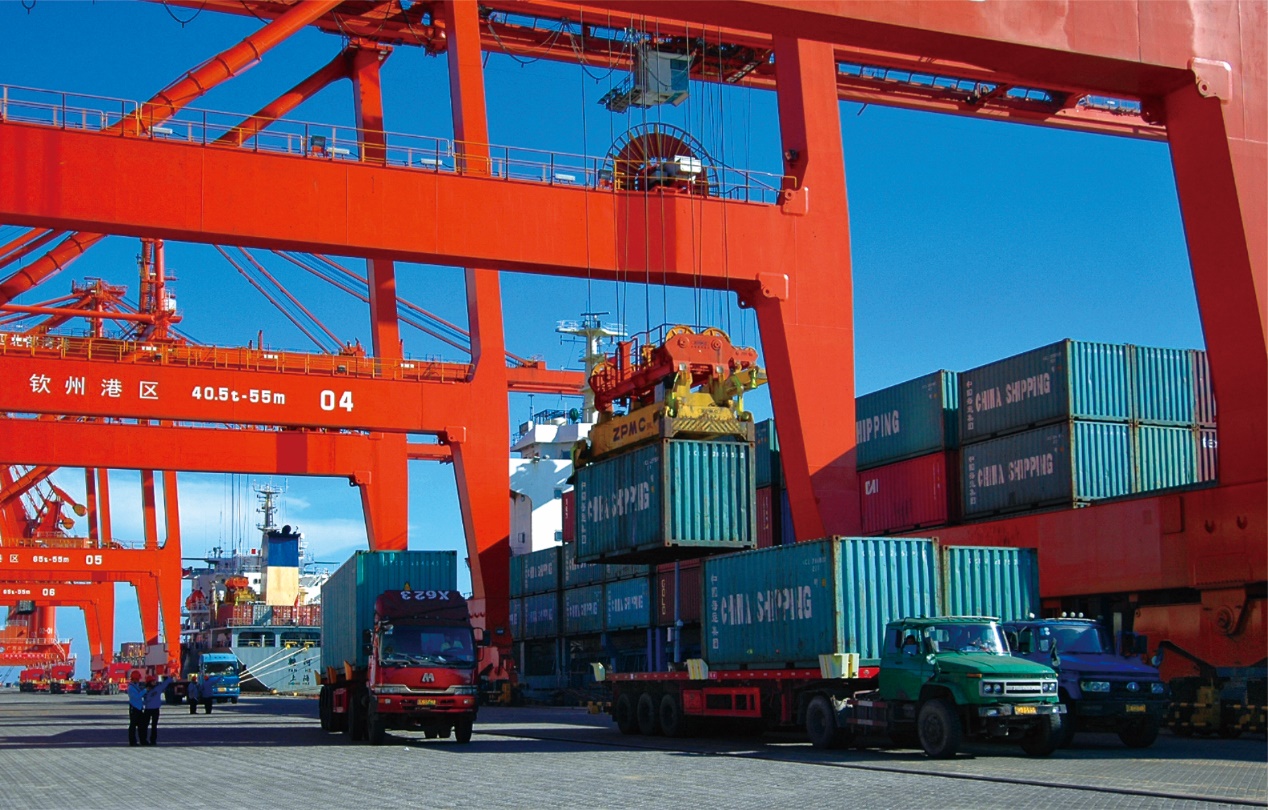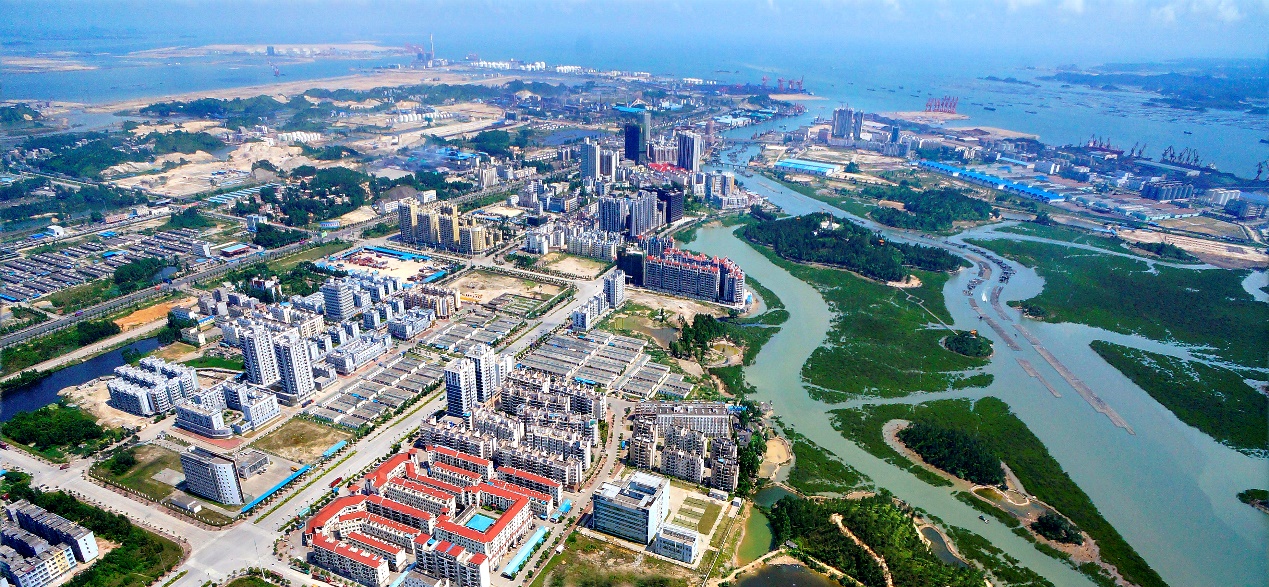

Written by Li Min and Zhao Yali / Translated by Zhang Xiaoyan
Qinzhou, located in the center of Guangxi Beibu Gulf Economic Zone, is the most convenient access to the sea in the central south, southwest and northwest regions of China with significant geographical advantages. The construction of the hub city of the New International Land-Sea Trade Corridor in west China, the establishment of Qinzhou Port Area of China (Guangxi) Pilot Free Trade Zone, the smooth progress of the project of Huayi integrated base of new chemical materials, which is the single project of the largest investment in Guangxi, and the opening of China’s first Huawei 5G Digital Town, etc. All of which are making Qinzhou thriving and prosperous thanks to the port and the sea.
Today, Qinzhou is striding forward and entering a new era of its own opening-up and development.

A picture of win-win cooperation based on favorable policies
Policy support will lead to new heights of innovation. Qinzhou has not only been favored by the national-level favorable policies for the New International Land-Sea Trade Corridor in west China and for the Western Development in China, but also covered by the support of other national-level special policies such as the policies for the pilot Free Trade Zone, “Two Countries, Twin Parks” and bonded port area, forming a pool of favorable policies and a highland of institutional innovation. In the meantime, Guangxi, the provincial-level autonomous region of China where Qinzhou is located in the south, adheres to the southward direction for development and focuses on promoting the integrated development of Guangxi Beibu Gulf Economic Zone and the three coastal cities in Guangxi. As a result, Qinzhou has received more and more policy support, with its status highlighted and playing a more and more important role.
In recent years, Qinzhou has continuously improved the level of opening-up, made efforts to upgrade the port infrastructure, optimized the customs clearance environment, and promoted the increasingly frequent trade exchanges and economic cooperation between Qinzhou and ASEAN countries, all of which have benefitted from the favorable policy support the city has received.
ASEAN has become the most important market for Qinzhou’s foreign trade. With the increasingly frequent bilateral trade between Qinzhou and ASEAN countries, various resource products from ASEAN countries such as mineral sand, coal, petroleum asphalt, wood pulp, palm oil, cassava starch and natural rubber are continuously entering Qinzhou Port, while Qinzhou’s textile and clothing, electromechanical equipment, liquefied gas, leather products and other goods are also exported to the Southeast Asian market in the form of border trade, processing trade and general trade. Qinzhou is gradually becoming one of the regional trade channels between China and ASEAN and the distribution center of some commodities between China and ASEAN.

A picture of integration based on “Two Countries, Twin Parks” of China and Malaysia
After 9 years of development, the China-Malaysia Qinzhou Industrial Park (CMQIP) has grown from small to large, achieving the goal of “laying the foundation in three years” and “reaping harvests in five years”. Driving along the wide and flat China-Malaysia Street into CMQIP, one can see a beautiful picture, which illustrates the integration of industry and city.
Shifting from the focus on infrastructure investment to attaching equal importance to infrastructure and industrial project construction, CMQIP has substantially completed the development and construction task of “seven connections, one leveling and one greening” over the space of 15 square kilometers in Phase I of the park-building project and provided the development framework of the park, which have created favorable conditions for attracting investment and industries, and laid the industrial foundation for sustainable development of the park. Among the infrastructures completed, the Electronic Information Industrial Park, the China-Malaysia International Science and Technology Park, the smart IoT Industrial Park, the bird’s nest processing and trade base, the youth apartment, the mangrove resettlement community, the China-Malaysia Plaza, the primary and secondary schools, the Internet creative education space and other projects have been put into use.
As the flagship project of the China-Malaysia cooperation and an important platform for the opening-up and development of Qinzhou, the “Malaysian element” is not only its unique advantage, but also the cornerstone of its deepening international cooperation. From highlighting Malaysia’s advantageous industries, to making good use of Malaysia’s cooperation resources, and then to the financial innovation practice tailored for the China-Malaysia international cooperation, CMQIP has moved forward steadily. By focusing on Malaysia’s advantageous industries such as bird’s nest, halal food and palm oil processing, CMQIP has made bilateral production capacity cooperation the core task of the park's development and become a hot land for Chinese and Malaysian investments.
From January to June 2021, the fixed asset investment of CMQIP was RMB 1.49 billion yuan (US$ 250 million), and the total output value of industries above designated size was RMB 7.4 billion yuan (US$ 1.14 billion), a year-on-year increase of 41.5%. As of June 30, 2021, there were 5,861 enterprises in stock in CMQIP, including 40 foreign-funded enterprises.
With the official inauguration and establishment of Qinzhou Port Area of China (Guangxi) Pilot Free Trade Zone (QPA) in 2019, Guangxi Zhuang Autonomous Region and Qinzhou Municipal government have integrated CMQIP, Qinzhou Bonded Port Area and Qinzhou Port Economic and Technological Development Zone to implement the coordinated development of the “three zones”, and CMQIP has ushered in a brand-new “free trade era”.
In order to strengthen the daily contact and interactive development of the “Two Countries, Twin Park”, the QPA Administrative Committee has specially established the Secretariat of the Joint Council and issued policies to promote the development of the Malaysian Development Consortium in QPA, paving the way for cooperation between Chinese and Malaysian enterprises.
A picture of ocean blue based on maritime trade
“One gulf connects seven countries, and one port connects the world”. Since being approved in 2019 by the national government, by thoroughly playing the “Three Strategic Roles” and fulfilling the new requirements of “Five Steadily”, QPA has experimented new measures, made independent reforms, and accelerated the construction of a gateway port for the new International Land-Sea Trade Corridor, a sea-oriented economic clustering area and a China-ASEAN Cooperation Demonstration Area, making remarkable achievements.
The sea-oriented economy has accelerated the clustering of production factors. Qinzhou has firmly grasped the great historical opportunity of the construction of the New International Land-Sea Trade Corridor and the establishment of China (Guangxi) Pilot Free Trade Zone, accelerated the clustering of sea-oriented economy, implemented the industrial development concept of “Strengthening Leaders, Supplementing Chains and Gathering Clusters”, which is focused on port and shipping logistics, international trade, green chemical industry and other industries, and has initially formed an advantageous industrial cluster with seaport characteristic and achieved the high-quality industrial development.
Remarkable results have been achieved in attracting large businesses of strength. In 2020, QPA has comprehensively promoted the program of “three types of enterprises entering Guangxi” (national-level State-owned enterprises, private enterprises, and enterprises in the Greater Bay Area of Guangdong, Hong Kong and Macao), and achieve good results in enterprise registration, project negotiation and introduction, project planning, funds received and foreign investment introduction. 75 new projects were signed throughout the year, with a total investment of RMB 229.6 billion yuan (US$ 35.46 billion); RMB 19.2 billion yuan (US$ 2.96 billion) of investment promotion funds were received, accounting for 101% of the annual forecast; 4,898 enterprises were newly added, accounting for 140% of the annual forecast; and 191,000 platform market entities were newly registered; the registered capital of domestic enterprises increased by RMB 159.97 billion yuan (US$ 24.7 billion), accounting for 229% of the annual forecast.
Port and shipping logistics has developed well despite the adverse situation. The Beibu Gulf Shipping Service Center has been in full operation, attracting the presence of 120 port and shipping logistics enterprises, and a number of modern logistics parks such as Zhonggu Logistics and GLP Logistics. The modern service industry has achieved leapfrog development. From January to April 2021, 1,848 sea-rail intermodal trains operated in the Beibu Gulf Port, an increase of 83%, and the container handling capacity of Qinzhou railway container center station reached 97,000 TEUs, an increase of 36.04%. The throughput of Qinzhou Port continues to grow rapidly. In 2020, the container throughput reached 3.95 million TEUs, an increase of 31%, and the port cargo throughput reached 136.5 million tons, an increase of 14.4%, making it the only port in China that has achieved double-digit growth in cargo and container throughput, ranking first among the major coastal ports in China.
The capacity of land-sea corridor has been upgraded. The adjustment project of phase I and phase II of the expansion of the east channel of Qinzhou Port has been accelerated. It is expected to be officially opened to navigation in September 2021. The projects such as the 300,000 ton oil wharf berth of Qinzhou Port are planned to be opened for acceptance within 2021. The transformation project of container automation of berths No. 7 and 8 in the Dalanping south operation area is comprehensively expedited, to be completed in June 2021. The construction of No.9 and 10 automatic container berths started in August 2020, with 20% of the overall progress completed so far and the civil work thereof planned to be completed by August 2022, when Qinzhou Port will be open to 200,000 ton container ships.
Taking the advantage of the Belt and Road Initiative and other favorable conditions, Qinzhou will advance bravely and achieve a higher level of development and a leap forward.
桂ICP备14000177号 Copyright@2006-2013 Guangxi China-ASEAN Panorama Magazine Agency Co., Ltd. All Rights Reserved